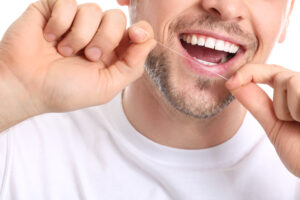 In our last blog, we discussed the importance of replacing your toothbrush regularly. Today, we are switching over to the other primary component of at-home preventative dentistry: flossing. This is frequently overlooked, and many people fail to do it regularly. Moreover, proper technique isn’t frequently talked about — at least compared to brushing — so today we are setting the record straight. In today’s blog, your Conroe, TX dentist talks about the importance of flossing and the right way for you to do it.
In our last blog, we discussed the importance of replacing your toothbrush regularly. Today, we are switching over to the other primary component of at-home preventative dentistry: flossing. This is frequently overlooked, and many people fail to do it regularly. Moreover, proper technique isn’t frequently talked about — at least compared to brushing — so today we are setting the record straight. In today’s blog, your Conroe, TX dentist talks about the importance of flossing and the right way for you to do it.
Why Is It Important?
Flossing is crucial because it reaches spaces between your teeth that brushing does not. When you do it, you are dislodging food particles that, if they remain, can cause tooth decay and gum inflammation. When decay gets bad enough, it can require a dental filling. It is also a significant cause of bad breath. You may notice that when you do not floss for a while, your gums bleed more frequently and that your trips to the dentist can be more painful. This is likely because your gums are developing gingivitis. While this is a fairly common issue when it gets severe enough, it can require more serious preventative measures to be taken — like scaling and root planing.
What Is The Proper Technique?
As noted above, we understand that flossing is easy to overlook in your at-home routine, but it is crucial that you do it at least once a day. Most people choose to do it at night, and this can be a good idea because you are removing any trapped food particles before they have the chance to linger between your teeth as you sleep. These food particles can cause a build-up of bacteria, so you want to remove them as soon as possible.
For the recommended technique, be sure to start with about 18 inches of floss, and wind most of it around your fingers, leaving a couple of inches exposed. When you are doing it, be sure to curve the floss around the base of each tooth, and make sure to go beneath the gum line. As you move from one tooth to the next, you should use new, clean sections so you aren’t just putting whatever you removed back in your mouth. While you want to remove as much as you can, do not be too aggressive, as this can cause discomfort and bleeding.
Types Of Floss
The primary types are nylon and PTFE. The former is available either waxed or unwaxed and is made up of many nylon threads. These can shred and break but are inexpensive and ubiquitous. PTFE, on the other hand, is made from a more durable, single strand is typically more expensive. You can also find water picks and other varieties of tools that can accomplish the same job.
Contact Us To Learn More
If you have any questions about flossing or preventative care in general, please reach out to us today. Schedule an appointment with The Dental Centre of Conroe in Conroe, TX by calling 936-441-4600.


